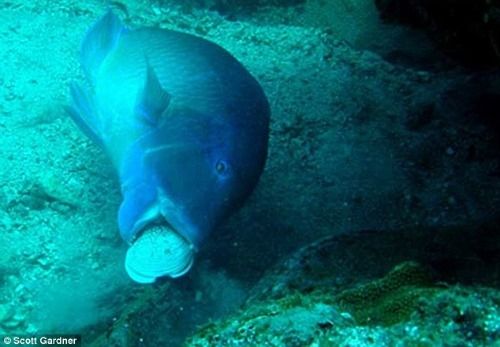Amazing Photos: Fish Uses Rock As a Tool

When marine biologist Scott Gardner was swimming back to his boat after a dive on the Great Barrier Reef, he heard a strange cracking sound and grabbed his camera — just in time to snap some photos of a green wrasse (also known as a tuskfish) smacking a small cockle against a rock to get at the meat inside.
While scientists have known for about 50 years that a few dozen species of fish use rocks as tool-like implements, this was the first time it had been witnessed up close and recorded with a camera.
"I was surprised only by the quality of the images. The fish didn't seem to care that he was sitting there snapping photos," said Culum Brown, a fish biologist at Macquarie University, who co-wrote an article about the findings with Gardner. "It's apparent to anyone who sees these pictures that this is a pretty smart fish doing clever things." [More photos]
The fish is smashing the cockle (a type of clam) against the rock, using it as an anvil rather than as a hammer, but that still clearly fits the definition of tool usage, Brown told Life's Little Mysteries.
That said, Brown admitted that it's tricky to define a tool for fish. The working definition for identifying animal tool usage use was written by primatologists observing monkey and ape behavior in the jungle. Those visual cues — poking things with a stick, hitting something with a rock, etc. — don't necessarily translate to underwater environments. [8 Weird Animal Facts]
"Fish don't have hands, and they don't operate in a terrestrial environment. If you try to swing underwater, you get too much resistance. And even if you pick up a rock underwater, it only weighs a fraction of what it weighs on land. So the types of things you see chimps doing wouldn't work underwater," he said, adding that the fish was using the rock in the most environment-appropriate way possible, which shows intelligence.
"Obviously the fish is manipulating the tool in some way — it is holding the [cockle] in a particular way, and it's striking in a very particular place on the anvil, which was the pointiest part. The fish wasn't wandering around aimlessly whacking it against any rock," Brown said. "It was targeting the tool to get maximum effect." [Can Goldfish Really Grow to 30 Pounds?]
Sign up for the Live Science daily newsletter now
Get the world’s most fascinating discoveries delivered straight to your inbox.
The ranks of animals that have shown tool-use behavior have grown recently to include octopuses, crows, parrots, and insects, along with primates and dolphins. Brown hopes that fish will soon be considered part of this group, and wants to continue his work in helping to paint a clearer picture of fish cognition.
"The amazing thing about this is that tool use is more common in fishes than we realize," he said, explaining that many researchers study cognition in primates and birds, but very few study cognition in fish. "We're working on creating a new definition of fish cognition and we're finding that there is little difference between these animals. They're just smart at different things."
This story was provided by Life's Little Mysteries, a sister site of LiveScience. Follow Life's Little Mysteries on Twitter @llmysteries, then join us on Facebook.













